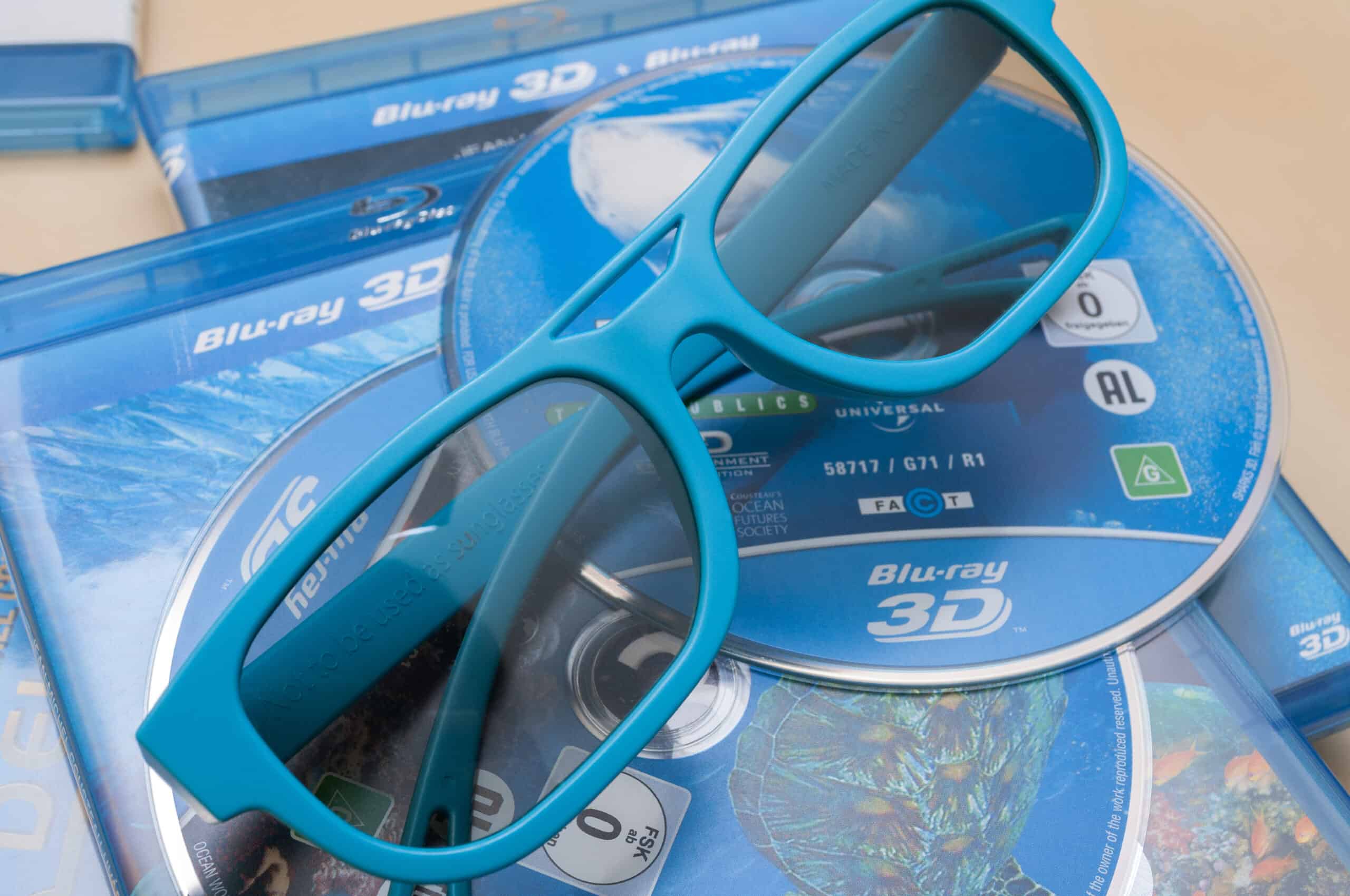Over the years, few industries have seen the kind of rocky roads the home video market has seen. For every successful format — the VHS, the DVD — there are countless others that failed to catch on. Throughout the 2010s, Blu-ray has toed the line expertly.
While never quite reaching the continued heights of the DVD, the Blu-ray has nevertheless managed to command a dependable part of the home video market. However, even the slightest bump in the road could threaten to disrupt that hold. Just look at the way the Blu-ray 3D failed.
Developed in an attempt to replicate the success the 3D format was seeing at the movie theater, the Blu-ray 3D failed to catch on the way the standard Blu-ray did. (Not to mention, it never even came close to the success of the DVD, which still triumphs over the Blu-ray today.)
But what actually happened to make the Blu-ray 3D fail so spectacularly? Given the success of 3D movies throughout the early 2010s, the fact that the Blu-ray 3D failed remains a real surprise. Let’s take a look at the history of the Blu-ray 3D, tracking its highs and lows to find out what really happened here.
Blu-ray 3D Specs
| Product Name | Blu-ray 3D |
| Product Type | 3D high-density optical disc |
| Released | December 17th, 2009 |
| Developer | Blu-ray Disc Association (BDA) |
| Storage Capacity | 25 GB (single layer) 50-66 GB (dual layer) 100-128 GB (BDXL) |
| 3D Technique | Stereoscopic |
Why Blu-ray 3D Mattered
Prior to the release of Blu-ray 3D in 2009, the only way to enjoy 3D movies at home was via those nifty red and blue cardboard glasses. Other than that, your only option for 3D was to enjoy it in the theater — again, using those red and blue glasses.
It wasn’t until the popularization of RealD 3D at the tail end of the 2000s that 3D was truly able to elevate itself to the 21st century. Using polarized light that produces a stereographic projection of images, RealD 3D corrected countless issues that existed with 3D prior to this revolution.
From darkening the images with red and blue lenses to obscuring the 3D illusion whenever the viewer moved their head even slightly, RealD 3D’s stereoscopic 3D process was exactly what 3D needed to transform from a novelty to a seriously viable box office strategy.

©vesperstock/Shutterstock.com
The release of James Cameron’s Avatar (2009) — the most popular and highest-grossing 3D movie of all time at nearly $3 billion gross — only cemented the success of the RealD 3D process. From there, 3D was a must for any major motion picture hoping to set box office records.
Naturally, this popularity and success at the box office led to a desire to bring the experience to the home video market, as well. There was so much money to be found in 3D, everyone from TV manufacturers and home video companies to Blu-ray retailers alike wanted a piece of the pie.
In conjunction with the 3D TV, Blu-ray 3D was born. While expensive, Blu-ray 3D mattered because it revolutionized the at-home viewing experience by making stereoscopic 3D possible in the home. This sort of thing never would’ve happened without the theatrical success of digital 3D.
How Did People Feel About Blu-ray 3D?
While 3D was selling magnificently at the theater for years following the record-setting success of Avatar, Blu-ray 3D saw less successful returns. People that wanted to build up a Blu-ray 3D collection couldn’t afford to do so.
Alternatively, those who could afford a proper Blu-ray 3D setup simply weren’t interested in the luxury format. After all, you’d need a 3D TV, a Blu-ray 3D player, a Blu-ray 3D collection, and enough 3D glasses for everyone in the home. An investment of this size would cost a person thousands.
The invention of 3D TVs that didn’t require glasses offered a slight glimmer of hope for the Blu-ray 3D. Toshiba, Vizio, LG, Sharp, and Sony all developed and tested their own versions of these glasses-free 3D TVs.
While owners of these TVs wouldn’t need to buy glasses in order to enjoy the format, the sheer cost of these improved 3D TVs almost made the problem of affordability even worse. After all, what was the point of doing away with glasses when the glasses-free 3D TV cost more than any set of glasses would?
In the end, the Blu-ray 3D proved that there’s a real distinction to be made between a casual interest and a serious interest. People were casually interested in the idea of watching 3D movies at home. However, they weren’t seriously interested enough to actually invest thousands into the equipment that would make it possible.
3D had transcended its novelty status at the movie theater. And yet, it was still relegated to this novelty categorization at home. People were interested in Blu-ray 3D, but not interested enough to actually buy into it en masse.
How Blu-ray 3D Failed: A Complete History
The Blu-ray Disc — which, since its 2006 debut, has been shortened simply to Blu-ray or BD — is a high-definition digital optical disc format. First developed in 2005 as a successor to the DVD, Blu-rays can hold far more than its predecessor format; and at a much higher picture quality to boot.
By definition, Blu-rays can display a picture quality as low as 720p and as high as 1080p and still qualify as HD. Blu-rays are also used to store current-gen video games for consoles such as the PlayStation 3 through the PlayStation 5, the Xbox One, and the Xbox Series X.

©Singha Songsak P/Shutterstock.com
The name “Blu-ray” is a reference to the blue (or, technically, violet) laser that reads the disc. Thinking back to what we learned about wavelengths and colors in our K-12 years, a violet laser has a shorter wavelength than the red laser used to read a DVD.
This means it can store more information at higher picture quality. The significance of all this information about standard Blu-rays? Well, without the popularization and success of the standard Blu-ray format, it never would have been possible to bring the RealD 3D process to home video with the Blu-ray 3D.
As 3D continued to thrive at the box office, the Blu-ray Disc Association (BDA) went to work assembling a task force. The task in question? How to fit 3D films and 3D TV shows onto a Blu-ray disc. The BDA brought together film industry executives, consumer electronics developers, and top researchers to create the Blu-ray 3D.
In December 2009, the BDA finally made it official. The Blu-ray 3D had arrived, and it would be backward compatible with standard Blu-ray players. What the minds behind the Blu-ray 3D failed to realize was that this wouldn’t actually be possible.
Early Signs of Imminent Failure
In theory, the BDA was correct. A Blu-ray 3D printed on a dual-layer Blu-ray disc could be read by your standard Blu-ray player. However, in practice, they proved to be way off by a seriously significant margin. While Blu-ray 3D could technically exist on a dual-layer disc, the truth was that a vast majority required triple- or even quadruple-layer Blu-ray discs in order to store the 3D film.
Naturally, standard Blu-ray players were incapable of reading triple- and quadruple-layer discs. Before Blu-ray 3D even had a chance to thrive, its developer had shot its own creation in the foot.
When trying together a proprietary technology off the ground, one of the worst things you can possibly do is fail to communicate key information about the product. Simply put, the task force that conceived the Blu-ray 3D failed to make the truth about the newfangled tech known.
In their minds, the 3D encoding used for the Blu-ray 3D — Multiview Video Coding, or MVC — was merely an extension of the encoding used for standard Blu-rays (Advanced Video Coding, or AVC). This was simply a theory, though. In practice, most 3D discs came with a limitation that forbade 2D viewing.
Once it became obvious that most standard Blu-ray players were incapable of playing 3D Blu-rays in 2D, the industry moved to include standard Blu-rays with Blu-ray 3D sales. This was only a temporary fix, however. With this move, the BDA suggested that a person would need an entirely separate player to watch their Blu-ray 3D discs.
This was not the wisest move. It now became clear to consumers that watching 3D movies at home was going to be an astronomical expense. Not to mention, the home video market was already continuing to decline year after year throughout the 2010s.
The Eventual Demise of Blu-ray 3D
Though the developers of the Blu-ray 3D failed to be forthright about the true cost of the format at the start, it was abundantly clear just a few years later. To enjoy a Blu-ray 3D, you’d need a 3D TV, 3D glasses, a Blu-ray 3D collection, and a Blu-ray 3D player. In other words, it was game over for the Blu-ray 3D.
Sony, one of the key figures behind the BDA, scrambled to make a fast fix. They developed a firmware update for the PlayStation 3 that allowed support for Blu-ray 3D. But, with the PlayStation 3 on its way out and the PlayStation 4 on the horizon, the move just wasn’t enough.

©DenPhotos/Shutterstock.com
By 2018, nearly every major studio had stopped releasing movies on Blu-ray 3D. Disney, Universal, MGM, Paramount, Sony… everyone but Warner Bros. had completely pulled out of the U.S. Blu-ray 3D market.
Interestingly enough, these studios kept producing and selling Blu-ray 3D in international markets. The 3D home video saw far more success on continents such as Australia, Asia, Europe, and South America. Meanwhile, Warner Bros. continued to churn them out both in the U.S. and abroad.
This demise was about more than just frustration over pricing. It coincided with the demise of 3D in movie theaters. Today, it’s becoming increasingly rare to even find a movie playing in 3D. A decade ago, they were a dime a dozen.
Disney continues to see mild success with their animated and comic book movies. Alas, few other studios dare to venture into the 3D format today. Naturally, the same would apply to Blu-ray 3D. In this context, it seems that the Blu-ray 3D failed to catch on because 3D itself failed to stick around.
Why Blu-ray 3D Failed
When you look at it this way, it only makes sense that Blu-ray 3D failed in tandem with 3D movies and 3D TVs themselves. It’s a uniquely 21st-century rise and fall. And, strangely, one that has a lot to do with James Cameron.
Cameron’s Ghosts of the Abyss (2003) was the first feature-length 3D IMAX film. This kicked off a series of 3D IMAX films including The Polar Express (2004) and Superman Returns (2006). 3D remained merely a specialty format until 2009, which was like a watershed moment.
My Bloody Valentine 3D (2009), The Final Destination (2009), Coraline (2009), Up (2009), and — most importantly — Avatar (2009). It was abundantly clear that 3D was moving beyond specialty and inching toward the standard. Once again, James Cameron was at the center of it all.
- Directed by James Cameron
- 20th Century Fox pictures
- Starring Sam Worthington, Zoe Saldana, Sigourney Weaver, and more
- Supports DTS, Dolby Digital 5.1
- Widescreen
As stated above, Avatar skyrocketed demand for 3D. Naturally, Avatar‘s gradual disappearance from the forefront of people’s minds had a similar effect on demand for 3D. A decade after Avatar‘s release, 3D of all shapes and sizes (including Blu-ray 3D) had receded again.
At the end of the day, it’s safe to say Blu-ray 3D failed because 3D itself failed, too. That’s not to say it’s failed for good, though. Not when a new Avatar film is on the way. James Cameron’s long-awaited Avatar sequel, Avatar: The Way of Water, is currently slated for a December 2022 release.
It’ll be presented in 3D, just like the first film (which was re-released in the fall of 2022 ahead of the sequel’s release). If The Way of Water does even half as well as the first film, it’s possible we might see a 3D revival into the 2020s. In the end, only time will tell.
Why Standard Blu-ray Succeeded
What’s to be learned from the continued success of standard Blu-rays over Blu-ray 3D and other specialty formats such as 4K UHD? The lesson is as simple as this: what works at the movie theater won’t always work at home.
It’s a classic case of “just because you can doesn’t mean you should.” Could couch manufacturers create 4D sofas that shake and poke and spray the viewer? Sure, of course, they could. But does that mean they’d be as successful at home as they would be in a movie theater? Absolutely not.
This is an exaggeration, of course, but there’s still truth to it. Just because people enjoy seeing 3D movies at the theater doesn’t mean they want to bring the experience home. It’s about more than just price, too.
The brightness of a room, the placement of a couch, the reduced quality of the consumer-grade glasses… it’s all going to deliver a less-than-ideal 3D movie-watching experience compared to the theater. That’s why Blu-rays and DVDs continue to sell well while Blu-ray 3D failed. Reduced cost, for one, but also increased comfort and practicality.
After a long day at work or a difficult hurdle in your personal life, you don’t want to sit down and watch a 3D movie. You just want to throw something on, sit back, and relax. You can’t really do that with 3D. Especially if you’re the kind of person who gets queasy or develops a headache from 3D.
The success of standard Blu-rays in the face of Blu-ray 3D’s failure is really that simple. 2D is just better than 3D for the home viewing experience. For now, until the technology improves for home viewers, 3D will remain something you’ll only find at the theater.
Up Next
- The Real Reason CED Failed Spectacularly
- Doomed from the Start: Why Google Stadia Failed
- The Real Reason UltraViolet Failed Spectacularly
- The 5 Reasons Blockbuster Failed Spectacularly
- The Real Reason HD DVD Failed Spectacularly
The image featured at the top of this post is ©JMiks/Shutterstock.com.

![Avatar 3D [3D Blu-ray]](https://history-computer.com/wp-content/uploads/2023/08/51WuXSVF2fL._SL500_.webp)


